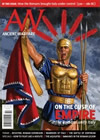|
|

Rome began as just another central Italian city state, little different to its Etruscan and Latin neighbours, but a combination of persistence and a system that turned defeated enemies into future allies saw her slowly gain control of the entire Italian peninsula. This issue of Ancient Warfare magazine focuses on some of those conquests, largely looking at them from the perspective of Rome's enemies.
Although the Samnites get their mentions, it is nice to see the other non-Roman powers of Italy getting more attention. The Greeks of southern Italy are the subject of several articles, and they were Rome's last significant opponents during the conquest of peninsular Italy (the Gauls of the north remained independent for longer, but during the Republic that area wasn't considered to be part of Italy proper, but instead was seen as part of Gaul). The Italian Greeks maintained their connections to their original homeland, and were able to summon help from Greece and the Balkans during this period, most famously Pyrrhus of Epirus, who managed to defeat the Romans in several battles, but at great cost.
The outstanding article in this edition looks at a two new frescos (from a set of five) that were rescued from grave robbers by the Italian police. The first shows a young man with a pack animal, the second shows a mounted warrior leading a prisoner and an allied footman. The mounted warrior was probably an aristocrat from Paestum, a southern Italian city with a mix of Greek and Lucanian inhabitants. The allied warrior can't be identified firmly, but does illustrate the variety of soldiers operating in Italy in this period. The prisoner may be a Roman, the main opponent of Paestum during the period of the Samnite and Pyrrhic Wars, the likely date of the frescos. The young man in the first fresco may be a servant of the mounted warrior. These are vibrant colourful artworks, and also a reminder that although Rome eventually triumphed, her opponents were independent for centuries, and even in the middle of the wars their rulers had the time and confidence to invest in elaborate grave paintings.
Many into one - Historical introduction
Legionary in Handcuff? - Interpreting a new fresco
Renowned horsemen - The Role of Italic Cavalry
Under Pressure - Greek Divisions in Italy
Piecing it all together - Reenacting Italic warriors
To govern Italy - the Battle of Sentinum
Sword, spear, or javelin? - Developing the Legion
How to be a Hoplite - Ancient ways revisited
The peltast - the art of tactics - part 2
The Aquilifer - Felsonius Verus and his eagle
The Immunes - Clerks, artisans, specialists
Go to Ancient Warfare Magazine Website